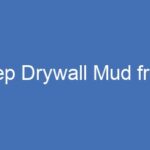Drywall tools are specialized items used exclusively for drywalling. Tools like a jab saw, sander, and sanding screens are not commonly used for other home improvement tasks. Fortunately, these are basic tools, allowing you to assemble a complete set without overspending. Additionally, some of these tools, such as a utility knife, may already be in your possession.
1. Drywall T-Square
A drywall T-square differs from other straight edges or squares with its full 48-inch length, enabling you to cut the entire width of a drywall sheet.
Moreover, the head (cross-end) of the square fits snugly over the drywall edge and is sufficiently long to ensure perfect alignment. While the T-square is a significant investment for DIY drywalling, there is no acceptable substitute. Furthermore, it can serve purposes beyond drywalling.
Tip
Some drywall T-squares have an adjustable head for angles of 30, 45, 60, and 75 degrees.



2. Drywall Knives
Drywall knives are specialized and standard putty knives won’t suffice. The good news is that drywall knives are reasonably priced.
The 6-inch and 4-inch knives are used for applying mud and taping. The 12-inch knife is for feathering and final coats. You’ll need either the 4- or 6-inch (they are largely interchangeable) and the 12-inch knife.
Tip
When buying taping and finishing knives, consider purchasing a mud pan to hold the drywall compound.
3. Utility Knife
If you already own a utility knife, it should suffice for your drywall project. Ensure it has interchangeable blades that securely set into a screw-down handle for added stability.
4. Cordless Drill
Professional drywall installers use screw guns that automatically load a new screw when needed. For significant drywall projects, renting such a screw gun may be beneficial.
For other drywall work, a standard 12V or 18V cordless drill will do the job. The 12V version can drive a few screws, while the 18V can draw screws into wood studs hundreds of times over.
Having a clutch on the cordless drill is helpful, as it stops the bit from turning at a certain point, preventing screw head stripping. Corded drills can be frustrating for drywall projects due to the cord and difficulty in torque control.
5. Sanding Screens
Drywall sanding sheets come in two essential types: coarse fiberglass mesh with open holes and sheets resembling regular sandpaper. The fiberglass mesh allows drywall dust to pass through, preventing clogging. The sandpaper type is crucial for finer sanding, as it takes longer for dust to accumulate, and can be cleaned with a whisk broom.
6. Sander and Sanding Pole
Mesh sanding sheets attach to the end of the sander and secure with wing nuts. The sander and sanding pole can be screwed together. Standard broom handles with compatible threads can serve as a sanding pole, saving you from buying a specialized one.
7. Drywall Sanding Sponges
A sanding sponge resembles a kitchen scrubber with an abrasive side and a smoother side. Another type is essentially a sponge without a coarse surface, specifically designed for dry-walling and used for wet sanding.
Tip
The sanding sponge is best for touch-ups, not for all your sanding needs.
8. Drywall Screws
The preferred drywall fastener today is the drywall screw, available in coarse-thread and fine-thread varieties. Coarse-thread screws effortlessly grip the wood and are versatile for various home improvement projects.
The 1 5/8-inch screw is generally practical for most drywall jobs, though 1 1/4-inch screws are commonly used with 1/2-inch drywall. Fine thread screws are suited for metal framing, while coarse threads are for wood studs.
9. Jab Saw
A jab saw is a hand saw with a six-inch blade (depending on the model), sharp tip, and coarse teeth. It functions much like a serrated kitchen knife. The tip is sharp enough for drywall penetration but not to the point of cutting your finger with light pressure.
The jabbing action is the key feature. When you lack an edge to start your cut, position the sharp end perpendicular to the surface and strike it with your free hand’s heel. A hammer or rubber mallet can also be used.



10. Electric Multi-tool
An electric multi-tool complements the jab saw. While jab saws excel at short straight cuts and rounded cuts, an electric multi-tool’s saw feature allows for long straight cuts, squares, and rectangles for electrical boxes, among other tasks.
Tip
Although not entirely dust-free, multi-tools are fairly effective at minimizing drywall dust. Plunge-cutting with a multi-tool produces very little dust.
11. Mud Pan
A mud pan is an essential tool used in drywall installation and finishing. It is a shallow, flat-bottomed container made typically of stainless steel or plastic. Drywall professionals use mud pans to hold and mix joint compound or mud, which is a thick paste used for covering joints and seams between drywall panels. The pan’s design allows for easy access and application of mud with a putty knife or taping knife during the taping and finishing stages of drywall work. It is also used in repairing drywall seam cracks during rectification. Mud pans come in various sizes, with popular dimensions being 12 inches and 14 inches.
Mud pans contribute to the efficiency of the drywall finishing process by providing a convenient and accessible reservoir for the joint compound. They are an integral part of the toolkit for professionals and DIYers alike, ensuring a smooth and seamless finish on drywall surfaces.
12. Drywall Hammer
A drywall hammer is a specialized instrument designed specifically for the installation and finishing of drywall. While it bears some resemblance to a standard hammer, there are distinct features that enhance its effectiveness for drywall tasks. One significant distinction lies in its hammerhead, which is broader and flatter than that of a typical hammer. Weighing approximately 12-13 ounces, this tool is lightweight, facilitating easy handling and reducing the risk of causing significant damage to the drywall surface.
Additionally, its rounded striking face minimizes unwanted marks and indentations on the drywall paper. Furthermore, the hatchet-like end on the hammer’s backside serves dual purposes: it can break smaller one-by’s and assist in lifting the lower portion of a drywall sheet.
13. Banjo
The banjo, when used in the context of drywalling, is a taping tool employed to apply joint compound and tape to drywall seams. It comprises a compartment for holding the joint compound and a tape dispenser. By using the banjo, the user can apply the compound to the seam and simultaneously feed the tape over the compound, enabling efficient and rapid taping of drywall joints. This tool is widely utilized by professionals in the drywalling industry to expedite the taping process and achieve consistent results.
In the realm of drywalling, the banjo serves as a taping tool that allows for the simultaneous application of joint compound and tape, thereby streamlining the taping process. It is an indispensable instrument for drywall tapers, often used in conjunction with other drywall tools such as taping knives and mud pans to attain a smooth and seamless finish on drywall joints. By utilizing the banjo, drywall professionals can significantly enhance the efficiency of the taping process, making it an essential component of their toolkit.
The banjo taping tool is an integral part of the equipment utilized by drywall tapers, as it facilitates the simultaneous application of joint compound and tape, reducing the time and effort required to tape drywall seams. This tool is frequently referenced in occupational summaries for drywall tapers, underscoring its significance in the drywalling industry. Moreover, discussions about the use of the banjo can be found in professional forums and industry resources, highlighting its relevance in the field of drywall installation and finishing.
14. Bazooka
The Bazooka is a cutting-edge tool extensively used in the drywall sector. It’s an automatic taping instrument that applies joint tape to the seams between drywall panels. The Bazooka features a long tube with a separate compartment for mud, ensuring a smooth and even application. It stands out from traditional taping tools as it can apply a specific quantity of mud while dispensing the tape. This dual functionality makes it a popular choice as it reduces work time and enhances productivity.
There are numerous Bazooka models available, one of which is the Columbia Predator Carbon Fiber Automatic Drywall Bazooka. Manufactured by Columbia Taping Tools, a company with nearly four decades of experience, this model is the first of its kind to incorporate carbon fiber. It’s significantly lighter than its counterparts and can tape flats and angles without causing any damage. It also features a removable cap for easy cleaning.
The Columbia Predator model’s side plates are made of stainless steel. In combination with the cable drum and creaser arms, they offer excellent corrosion resistance. A six-wheel cutting sleeve provides a smooth glide, excellent grip, and a pull ring for compatibility with higher ceilings. The tool maintains a constant temperature and is warm to touch regardless of the weather. It also includes a standard adjustable brake and quick release for tape changing. A Titanium pull rod adds a unique touch to this innovative taping tool.
To sum up, the Bazooka is a game-changer in the drywall industry, enabling professionals to achieve quick and precise results when taping walls. This automatic taper applies the right amount of paper tape and joint compound to flat joints, butt joints, and internal corners, ensuring a professional finish.
14. Trowel
The Trowel is a key instrument in the drywall sector, primarily utilized for spreading and smoothing joint compound across a broad surface area. Its flat, broad blade enables efficient coverage, making it ideal for taping seams and applying joint compound to larger sections of the wall. Possessing a drywall trowel equips you with the ability to overcome flaws.
Drywall trowels are available in a variety of sizes, typically between 11 and 18 inches in length and 4.5 inches in width. They are rectangular and include other variants such as a pointing trowel and an adjustable off-angle drywall trowel. A drywall trowel is essential for achieving a smooth finish on interior walls and ceilings.
The market offers a wide range of trowel models. For example, the LEVEL5 12″ Drywall Trowel is a highly authentic tool for smoothing and finishing drywall compounds, gypsum coats, stucco plasters, or the exterior insulation and finish system (EIFS). It features a high-grade 0.5mm flat golden stainless steel blade that has undergone triple hardening. The blade’s edges and corners are precision-ground and pre-broken, with subtle and uniform concave bends to avoid leaving a line after plastering. This drywall trowel has a 0.5 precision flex to alleviate wrist and hand fatigue and enhance direct sensitivity for accurate mud application, resulting in a superior, professional finish. It has a handle made of lightweight, heavy-duty powder-coated aluminum, wrapped in brushed leather for a comfortable grip. The blade is robotically welded to the handle with robust stainless-steel surface-mounted rivets for durability and longevity.
The trowel is indispensable in the drywall industry. It is a highly adaptable tool suitable for both home improvement and professional tasks. Its robust construction and ease of use make it the go-to tool for all drywall projects.
15. Mixing Paddle
The Mixing Paddle is a crucial tool in the realm of drywall. Its primary function is to blend various substances such as drywall compound, paint, plaster, grout, cement, and other low-density materials. The design of the mixing paddle ensures a uniform mix, which is vital for a smooth and even finish in drywall tasks.
Mixing paddles are available in a range of sizes and designs to meet specific requirements. They are usually made from robust materials like steel to endure the demands of mixing dense compounds. Some models, like the QEP 16 in. Universal Mixing Paddle, are designed for mixing small quantities of thinset, grout, mortar, cement, and plaster. These paddles are designed to lessen torque and strain on the drill, making them compatible with both corded and cordless drills.
A popular model in the market is the LEVEL5 12″ Drywall Mixing Paddle. It is recognized for its superior construction and effectiveness in blending drywall compounds, gypsum coats, stucco plasters, or the exterior insulation and finish system (EIFS). The paddle is designed to reduce drag and wear on your power drill. This design aids in providing a splatter-free operation by pulling material down into the center of the mixer head.
The Mixing Paddle is a key tool in the drywall industry. It ensures a consistent mix of materials, which is essential for achieving a smooth and professional finish. Whether you’re a professional contractor or a DIY enthusiast, a mixing paddle is a must-have tool for any drywall project. It not only saves time and effort but also ensures the quality and consistency of your work. So, the next time you embark on a drywall project, make sure a mixing paddle is part of your toolkit.
tag: # Drywall Tools







